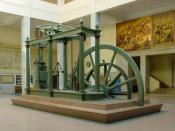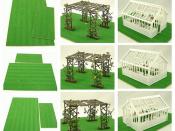The Industrial Revolution began in Britain in the 18th century and is still continuing in some parts of the world. The replacement of manual labour by machines happened. Goods that were made in home or small workshops began to be manufactured in the factories. It led to growth of cities and people moved from rural to urban areas in search for work places and doing business. Social places also took change. The Industrial Revolution was the first step in the modern economic growth and development.
Medical treatment improved so life conditions were better and people lived longer. Industrialization also brought factory pollutants and greater land use which harmed natural environment. There was an extensive loss of habitat for animals and plants, decline of natural resources.
-Steam: Steam engine maybe the most important machine technology. In 1689, Thomas Savery invented the steam engine to pump water from mines. Thomas Newcomen developed an improved version by 1712.
James Watt made the most significant improvements, allowing steam engine to be used in many industrial spheres.
-Iron and Coal: The most important advance in iron production occurred in 1784, Henry Cort invented new techniques for rolling taw iron ( a finishing process that shapes iron into the desired form and shape). Iron wasn't very expensive, so this way allowed using it in building heavy machinery etc. Because of its strength and durability, iron came to use in many industries.
-Textile: In earlier times, the spinning yarn and weaving of cloth was the everyday work for most of the families. This lasted for many centuries. The first important invention in textile production came in 1733, john Kay invented the "flying shuttle", which was partly mechanized, and made weaving easier. An invention of spinning jenny (a machine that spins a number of threads at once) then...


![English: URL:[www.humanthermodynamics.com/HT-history.html] Description: Savery Steam Engine [1698]](https://s.writework.com/uploads/6/69583/english-url-humanthermodynamics-ht-history-html-description-thumb.jpg)